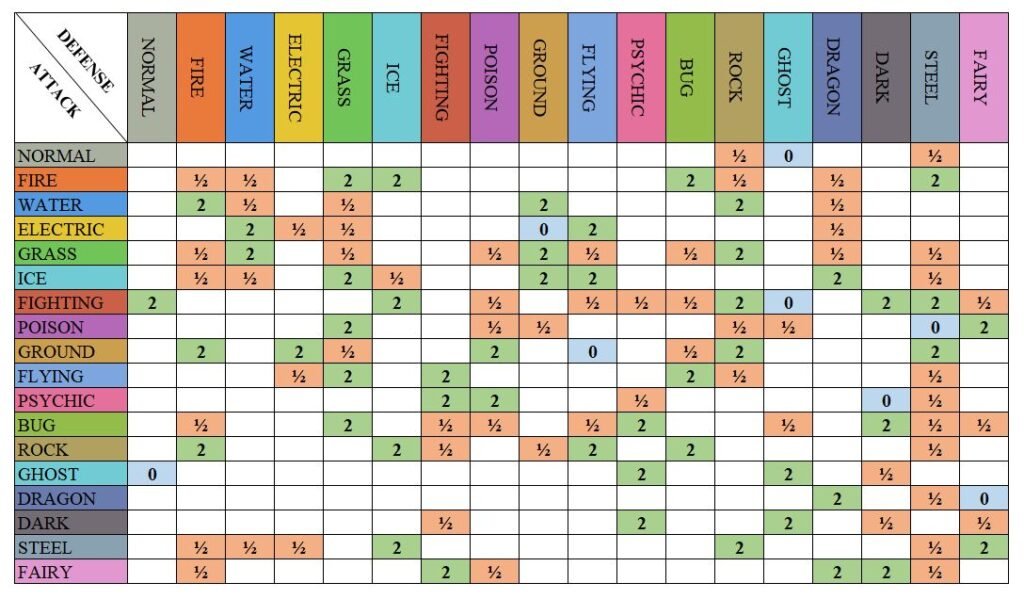Pokémon types and type charts
In the Pokémon universe, types are classifications that determine the strengths and weaknesses of Pokémon and their moves. Each Pokémon and move is associated with one or more types, which play a crucial role in battles. The type system creates a rock-paper-scissors dynamic, where certain types are strong against others and weak against different ones. This system encourages strategic planning and enhances the complexity of battles.
List off all Pokémon types
As of the latest games, there are 18 distinct Pokémon types plus one special.
Most types were introduced in Generation I, with the Dark and Steel types added in Generation II and the Fairy type introduced in Generation VI.
Before Generation III, there was a Bird type, which was only assigned to glitch Pokémon like MissingNo. This type was removed in later generations.
Additionally, before Generation V, there was a ??? type exclusively associated with the move Curse, which existed only (frome Generation II to V) in Pokémon Colosseum, Pokémon XD: Gale of Darkness, and Pokémon GO.
As of Generation IX, a Stellar type can be obtained by Terastallizing a Pokémon or move.
A Pokémon can have up to two types. These types can significantly influence their strengths and weaknesses in battles. Some Pokémon may change types when they evolve, or they may have alternate forms with different types.
So Pokémon can be:
- Single Typing: A Pokémon that has only one type. For example, Pikachu is an Electric-type Pokémon.
- Dual Typing: A Pokémon that has two types. For example, Charizard is a Fire/Flying-type Pokémon.
Pokémon type chart
The type effectiveness chart dictates how much damage a move will deal based on the type of the move and the type of the target Pokémon. Moves can be:
- Super Effective (2x damage): The move deals double damage.
- Not Very Effective (1/2x damage): The move deals half damage.
- No Effect (0x damage): The move deals no damage at all.


For example, Water-type moves are super effective against Fire-type Pokémon but not very effective against Grass-type Pokémon.
Dual-typed Pokémon have interactions with type effectiveness that are a combination of both their types. For example, a Charizard (Fire/Flying) is doubly weak to Rock-type moves due to both Fire and Flying being weak to Rock.
Type-Specific Abilities
Certain Pokémon abilities interact uniquely with their types, enhancing their battle strategies and overall effectiveness. For example, the ability “Levitate” grants immunity to Ground-type moves, regardless of the Pokémon’s type. This makes it invaluable for Pokémon that might otherwise be weak to Ground-type attacks.
Other abilities, such as “Water Absorb” allow Water-type Pokémon to heal when hit by Water-type moves, turning an apparent weakness into a tactical advantage. “Flash Fire” grants immunity to Fire-type moves and boosts the power of Fire-type moves if the Pokémon is hit by one, while “Volt Absorb” works similarly for Electric-type Pokémon. These abilities are crucial in defining how Pokémon perform in battles, providing layers of strategy for trainers to exploit.
Type-Specific Moves
Moves also have types, and their effectiveness in battle depends on both the move’s type and the target Pokémon’s type(s). Each move is categorized into one of the Pokémon types, such as Fire, Water, Grass, etc., and its impact is influenced by type matchups. For example, a Water-type move is super effective against Fire-type Pokémon but not very effective against Grass-type Pokémon. Some moves are exclusive to certain types of Pokémon or can only be learned by Pokémon of a specific type.
For instance, “Hydro Pump” is typically found on Water-type Pokémon, and “Flamethrower” on Fire-type Pokémon. Additionally, there are moves that provide benefits or hinderances based on the user’s type, like “Roost” which is primarily learned by Flying-type Pokémon to heal themselves. “Dragon Dance” is often learned by Dragon-type Pokémon to boost their Attack and Speed stats. These moves, combined with abilities and type interactions, create a complex and dynamic battle system that encourages diverse team compositions and strategic planning.
Summary
Understanding Pokémon types is fundamental to mastering battles in the Pokémon series. Each of the types offers unique strengths and weaknesses, influencing not only how Pokémon perform in combat but also their interactions with moves and abilities.
Types are more than just labels; they define the essence of a Pokémon’s capabilities and play a critical role in shaping the dynamics of battles. The interplay between types, abilities, and moves adds layers of strategy that can turn the tide of a battle. Moves, categorized by type, further influence battle outcomes through their effectiveness against different Pokémon types. The exclusivity of certain moves to specific types adds another layer of strategy, as trainers must consider not only the type matchups but also the unique moves that their Pokémon can learn.
In addition to influencing battle strategies, types also play a crucial role in the Pokémon universe’s lore. Each type is associated with various Pokémon species, habitats, and mythologies, enriching the game’s storytelling and immersion.
Ultimately, mastering the intricacies of Pokémon types is essential for any trainer aiming to become a Pokémon Champion. By understanding how types influence battles, moves, and abilities, trainers can develop comprehensive strategies that maximize their Pokémon’s strengths and exploit their opponents’ weaknesses. This knowledge is the cornerstone of becoming a skilled and successful Pokémon trainer, capable of navigating the complexities of the Pokémon world with confidence and expertise.
